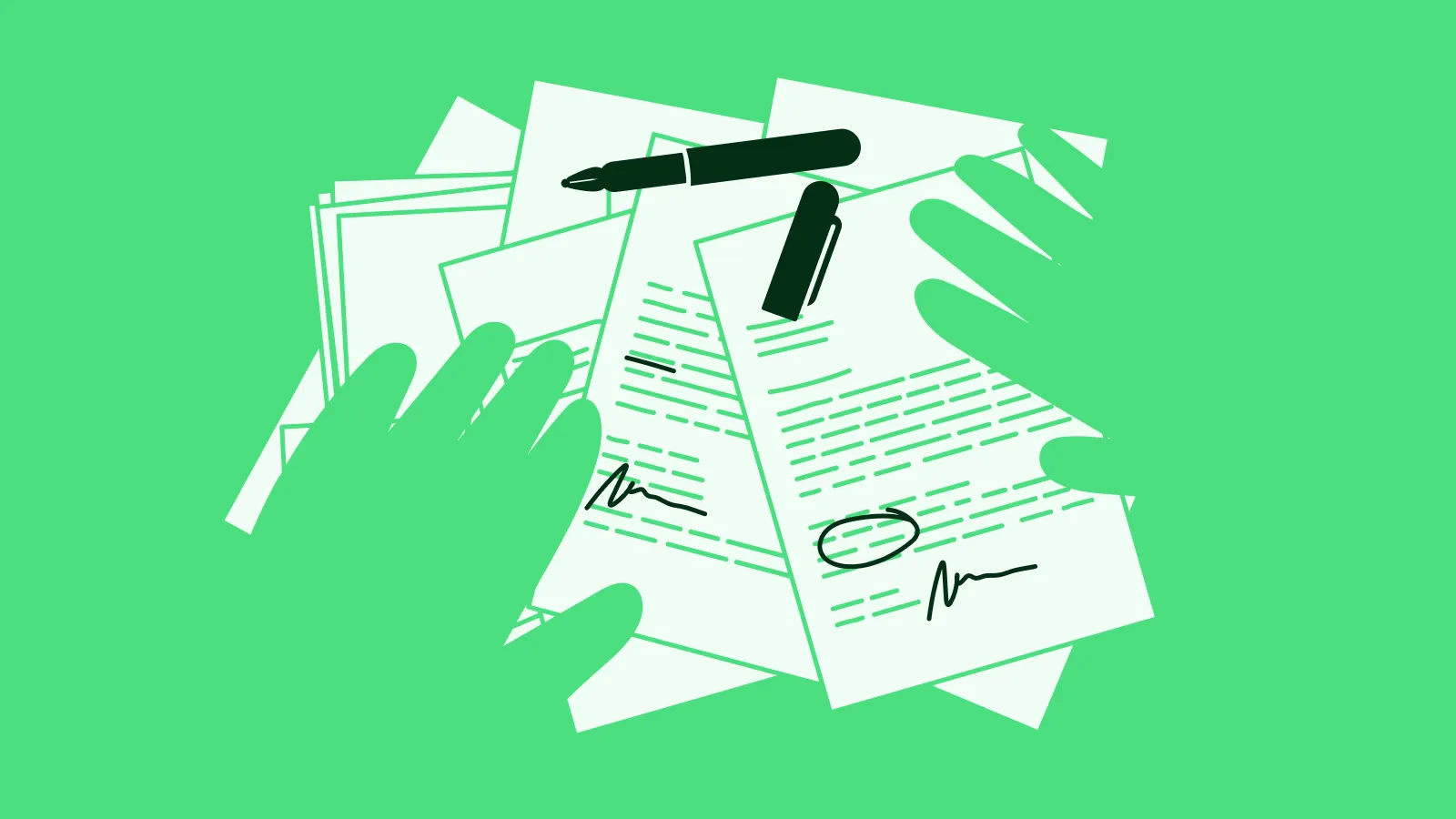Guarantor Mortgages
Bridge the gap to homeownership with a helping hand from your family.
Exclusive broker partner to

Author: Michael Whitehead, Head of Content
Reviewer: Paul Coss, Haysto Co-Founder and Chief Customer Officer
Updated: Oct 01 2025 9 mins
If you’re struggling to save up enough deposit or worried your income might be too low to buy the property you want, a guarantor mortgage could be the simple solution you’re looking for. This setup brings a trusted family member into the process to provide the security or income boost you need.
In this guide, we’ll break down exactly what a mortgage guarantor is, how this arrangement works, and the upsides and downsides for both you and your guarantor. By the end, you’ll have a clear understanding of whether this path is the right one to take toward homeownership.
Quick Summary:
A guarantor mortgage allows a family member to use their income or assets as security for your home loan.
The arrangement helps you buy a home sooner by solving two main issues: needing a larger deposit or boosting your borrowing capacity.
The guarantor is not a legal owner of the property but is fully responsible for 100% of the repayments if you cannot pay.
Guarantors must typically be UK resident homeowners with excellent credit and sufficient income to cover both their own commitments and your mortgage.
Joint Borrower Sole Proprietor (JBSP) mortgages and Family Offset schemes are popular alternatives that may carry less risk for the family member.
What Is a Guarantor Mortgage?
A guarantor mortgage is a type of home loan designed to help buyers (often first-time buyers) who don't meet the standard lending criteria on their own. The core idea is that a third party (the mortgage guarantor) agrees to take legal and financial responsibility for the loan if the main borrower can't keep up with the monthly repayments.
The guarantor's involvement provides an extra layer of security for the lender. This security can come in two forms:
Using their income to boost the affordability of the loan.
Or
Securing the debt against an asset they own, like their own home or a lump sum of savings.
This greatly reduces the risk for the mortgage lender, making them much more likely to approve the application.
Crucially, the guarantor is not named on the title deeds of the property you’re buying. They have no legal ownership claim to the home, but they are fully and legally liable for the debt if you default on it. This distinction is vital, particularly when considering tax implications and long-term ownership.
How Are They Different From Standard Mortgages?
The main difference between a guarantor mortgage and a standard residential mortgage lies in the liability. With a standard mortgage, only the named borrower(s) are financially responsible for the debt. With a guarantor mortgage, the responsibility is shared, but the ownership is not.
When applying for a standard mortgage, the lender assesses the applicant's income, deposit, and credit history alone. For a guarantor mortgage, the lender assesses both the borrower's and the guarantor's financial situations. They must be sure that if you, the borrower, stop paying, the guarantor for a mortgage has the income or assets to cover the shortfall immediately.
Here is a quick overview of the commitment both parties are agreeing to:
Aspect | Borrower's Agreement (You) | Guarantor's Agreement (The Third Party) |
|---|---|---|
Ownership | Sole legal owner of the property. | No legal ownership or claim to the property. |
Repayment | Legally responsible for making all monthly repayments. | Legally responsible for making all repayments if the borrower defaults. |
Security | The new property is security for the loan. | Provides their own home (or savings) as additional security. |
Risk | Risk of repossession if payments are missed. | Risk of losing their home or savings if repayments are missed. |
Credit Record | Affected by all payments (good or bad). | Only affected if they have to step in and make payments. |
Why Do You Need a Guarantor for a Mortgage?
People often turn to a guarantor mortgage when they’re financially close to being eligible for a standard mortgage but just need a helping hand over the line. The two most common reasons for needing a guarantor are issues with deposit size and affordability.
Deposit Issues
Many buyers, especially first-time buyers, struggle to save the minimum 5% or 10% deposit required by lenders. With a guarantor mortgage, the guarantor can offer their savings or home equity as security, rather than a cash deposit. Some of these products even allow for 100% borrowing, meaning you don't need any deposit at all.
Affordability Issues
Lenders use strict income multiples (usually 4.5 to 5 times your annual salary) to decide how much you can borrow. If your income doesn't allow you to borrow enough to buy the home you want, a guarantor’s income can be included in the affordability assessment. This increases your combined borrowing potential, closing the gap between what you need and what you can afford. This is often necessary for those with lower or non-standard incomes.
How Much Can You Borrow for a Guarantor Mortgage?
The amount you can borrow with a guarantor mortgage is often significantly higher than what you could achieve alone. This is primarily because the lender can assess the application using the guarantor’s financial strength, credit history, and income, especially if affordability is the main issue.
Lenders will typically look at the combined income of the borrower and the guarantor, applying their standard income multiples (usually 4.5 to 5 times combined income). Since the guarantor often has a higher or more established income, this immediately boosts the total loan size available.
Here’s a simple example of how this could work:
Imagine you’re a first-time buyer who earns £30,000 per year with minimal existing debt. A standard lender offering 4.5x your salary would likely lend you up to £135,000. If the house you want to buy has a purchase price of £200,000, you have a £65,000 shortfall, which is a lot to cover with a cash deposit.
Now, imagine a family member (typically a parent) agrees to be your mortgage guarantor. Let’s say their annual income is £60,000 and they’re mortgage-free on their own home.
Scenario | Borrower Income | Guarantor Income | Borrowing Multiple (4.5x) | Max Borrowing |
|---|---|---|---|---|
Standard Mortgage (Sole income) | £30,000 | £0 | 4.5 x £30,000 | £135,000 |
Guarantor Mortgage (Combined) | £30,000 | £60,000 | 4.5 x £90,000 | £405,000 |
By adding a guarantor, your borrowing limit can skyrocket, allowing you to easily secure a mortgage for a property worth £200,000.
(The actual amount offered will still depend on a full affordability assessment of both parties.)
Why Pick Picnic?
With access to thousands of mortgage products, easy-to-use technology, and 100+ experts, our award-winning service is with you every step of the way.
No impact on your credit score.
Who Can Be a Guarantor for a Mortgage?
Not just anyone can be a guarantor for a mortgage; lenders have strict criteria to ensure the arrangement provides genuine security. Since the role carries such a significant financial risk, lenders want complete confidence in their financial stability.
The guarantor is typically expected to be a close family member, such as a parent, grandparent, or sometimes a sibling, though some specialist lenders may consider a close friend.
Here are the standard requirements most lenders look for in a mortgage guarantor:
Age and term: They must be over 21, and some lenders require them to be below a certain age by the end of the mortgage term (often 75).
UK resident: They must be a UK resident with their main income paid into a UK bank account.
Homeowner status: Most lenders insist the guarantor is already a homeowner. Ideally, they will either own their property outright or have a substantial amount of equity in it.
Financial stability: They must have an excellent credit history and sufficient income to comfortably cover both their own financial commitments and the entirety of your mortgage repayment if you default.
Remember, the guarantor will be subject to the same strict financial checks as the main borrower to ensure they can fully meet the commitment they are signing up for.
What Are the Pros and Cons of Guarantor Mortgages?
Like any financial product, guarantor mortgages have clear benefits but also come with some drawbacks to be mindful of. Here's the good and the bad.
Why they’re a great idea | What to look out for |
|---|---|
Buy Sooner: Get on the property ladder years earlier, often without needing a large cash deposit. | High Risk for Guarantor: The guarantor’s home or savings are at risk if the borrower defaults. |
Increased Borrowing: The combined income makes it possible to borrow more, securing a better property. | Guarantor Liability: They are legally tied to the debt for many years, potentially restricting their own borrowing capacity. |
Access to 100% LTV: Some niche deals allow you to borrow the entire property value (100% LTV). | Limited Lender Choice: Fewer lenders offer these products compared to standard mortgages. |
Better Rates: A stronger guarantor profile can sometimes unlock more competitive interest rates than if you applied alone with a low deposit. | Legal Complexity: The process is more complex and requires both parties to take independent legal advice. |
Credit Building: The borrower establishes a positive payment history, making it easier to remortgage on their own later. | Relationship Strain: Financial difficulties can cause severe stress on family relationships. |
What Are the Alternatives?
While a guarantor mortgage is a solid option, it involves significant risk for the guarantor. It's always worth exploring other alternatives that may provide the help you need with less liability for your family members.
Joint Borrower Sole Proprietor (JBSP) Mortgage: This is often seen as a modern alternative. With a JBSP mortgage, a family member is named on the mortgage to boost affordability but is not named on the title deeds (proprietorship). They use their income, but not their home or savings, as security. This is particularly popular because it avoids the additional Stamp Duty surcharge that might apply if the non-owner were named on the deeds.
Family Offset Mortgages: These innovative products work by linking a family member's savings to your mortgage. The savings don't act as a deposit, but they offset the mortgage balance you pay interest on. For example, if you borrow £200,000 and the family member links £50,000 in savings, you only pay interest on £150,000. The family member still owns their savings, which are fully repaid to them once the agreed term ends or the borrower remortgages.
Government Schemes: For first-time buyers with small deposits, schemes like the Freedom to Buy Scheme (for 95% LTV loans) or Shared Ownership (part-buy, part-rent) may be a simpler route to explore first. These don’t require a family member to take on personal liability for the debt.
Why Pick Picnic for Your Guarantor Mortgage?
Guarantor mortgages are a relatively rare mortgage product, with a limited number of lenders offering them. Finding the right lender on your own could be a challenging and time-consuming process. Having an experienced mortgage broker on your side - like us! - makes things much easier and more efficient.
With access to these types of mortgage products, easy-to-use technology, and 100+ experts, our award-winning service is with you every step of the way. Here’s how we can help:
Finding you the best guarantor mortgage deals: Our mortgage team will already know which lenders are currently offering the most competitive rates for this type of home loan. They can compare the current guarantor mortgage deals available to find the one that’s right for your circumstances, including exclusive offers not generally available elsewhere.
Your mortgage, made simple from start to finish. Our online portal allows you to track your mortgage application step-by-step, sign and upload documents in seconds, and contact your mortgage team at any time. No back-and-forth emails. No printing. No guesswork. Everything you need, all in one place, so you can stay organised and in control of your mortgage journey.
Making mortgages possible, whatever the circumstances: Our team of advisors have a clear understanding of the eligibility criteria used by each lender and will identify the one that's best placed to help. Our sister brand, Haysto, has become the No.1 destination for customers who've been turned away elsewhere. For anyone with a complex income or adverse credit record - we’ve got your back!
Start Your Mortgage Journey with Picnic!
A guarantor mortgage is a powerful tool for overcoming those tough hurdles, like a small deposit or lower income. It uses the financial strength of a trusted family member to get you the funding you need, all while you build your own positive credit history toward standing on your own feet later on.
It’s an excellent route, but it's crucial that both you and the mortgage guarantor fully grasp the serious, long-term risk involved. Your family's assets could be on the line, so getting independent legal and financial advice is a non-negotiable step before you proceed.
Ready to start your mortgage journey? Get in touch with our Mortgage Experts today, and we'll compare all the available options to find the clearest, safest path forward for you.
Frequently Asked Questions
The key difference lies in the security and liability structure. With a Guarantor Mortgage, the guarantor typically provides their own home or savings as collateral. They only step in and become liable for payments if the borrower defaults.
With a Joint Borrower Sole Proprietor (JBSP) Mortgage, the non-owner is added as a 'joint borrower' from day one, meaning they are fully and equally liable for the monthly payments alongside the owner. The JBSP structure uses the joint income to increase affordability, but does not always require the co-borrower to secure the loan with their assets.
Yes, the borrower is still liable for Stamp Duty Land Tax (SDLT) as the sole legal owner of the property. The good news is that because the guarantor is not a legal owner, the additional 3% Stamp Duty surcharge for second homes does not apply to the transaction.
If you're a first-time buyer using a Guarantor Mortgage, you will still be eligible for first-time buyer Stamp Duty relief on properties up to £500,000.
Generally, having a clean guarantor mortgage on your record will not stop you from getting your own. However, when you apply for your own home loan, the lender will ask you to declare your status as a guarantor. They will then factor the possibility of you having to take over the existing repayments into their affordability assessment.
This usually means your maximum borrowing capacity for your own home could be reduced because the lender sees you as having a higher potential monthly outgoing.
Related Pages
The Picnic Guide To Buying a Home

How Conveyancing Works

How Stamp Duty Works

Choosing Your Mortgage

Speak to One of Our Experts
First or next move, remortgaging or investing - get clear advice from our award-winning experts to help you find the right mortgage.
No impact on your credit score.